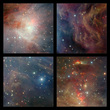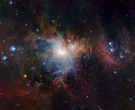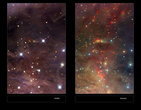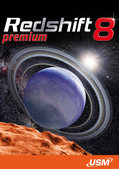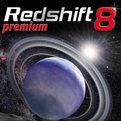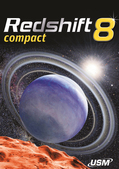Orion in a New Light
VISTA Eyes Orion
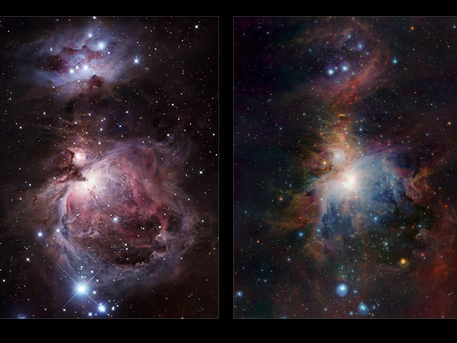 © ESO/J. Emerson/VISTA & R. Gendler
|
The left-hand panel shows the Orion Nebula in visible light. Most of the light from the spectacular clouds comes from hydrogen gas glowing under the fierce ultraviolet glare from the central hot young stars. The region above the center is clearly obscured by dust clouds. On the right the VISTA infrared view is shown. By observing infrared light many new features appear, including large numbers of young stars close to the center and many curious red objects, associated with young stars and their outflows, in the region above the center.
The Orion Nebula lies in the sword of the famous celestial hunter and is a favorite target both for casual sky watchers and astrophysicists alike. It is faintly visible to the unaided eye and appeared to early telescopic observers as a small cluster of blue-white stars surrounded by a mysterious gray-green mist. The object was first described in the early seventeenth century although the identity of the discoverer is uncertain. The French comet-hunter Messier made an accurate sketch of its main features in the mid-eighteenth century and gave it the number 42 in his famous catalog. He also allocated the number 43 to the smaller detached region just above the main part of the nebula. The Orion Nebula is a vast stellar nursery lying about 1350 light-years from Earth.
Although the nebula is spectacular when seen through an ordinary telescope, what can be seen using visible light is only a small part of a cloud of gas in which stars are forming. Most of the action is deeply embedded in dust clouds and to see what is really happening astronomers need to use telescopes with detectors sensitive to the longer wavelength radiation that can penetrate the dust. VISTA has imaged the Orion Nebula at wavelengths about twice as long as can be detected by the human eye.
As in the many visible light pictures of this object, the new wide field VISTA image shows the familiar bat-like form of the nebula in the center of the picture as well as the fascinating surrounding area. At the very heart of this region lie the four bright stars forming the Trapezium, a group of very hot young stars pumping out fierce ultraviolet radiation that is clearing the surrounding region and making the gas glow. However, observing in the infrared allows VISTA to reveal many other young stars in this central region that cannot be seen in visible light.
Looking to the region above the center of the picture, curious red features appear that are completely invisible except in the infrared. Many of these are very young stars that are still growing and are seen through the dusty clouds from which they form. These youthful stars eject streams of gas with typical speeds of 430,000 mph and many of the red features highlight the places where these gas streams collide with the surrounding gas, causing emission from excited molecules and atoms in the gas. There are also a few faint, red features below the Orion Nebula in the image, showing that stars form there too, but with much less vigor. These strange features are of great interest to astronomers studying the birth and youth of stars.
This new image shows the power of the VISTA telescope to image wide areas of sky quickly and deeply in the near-infrared part of the spectrum. The telescope is just starting to survey the sky and astronomers are anticipating a rich harvest of science from this unique telescope.
Orion in a New Light
VISTA Eyes Orion
 © ESO/J. Emerson/VISTA & R. Gendler
|
The left-hand panel shows the Orion Nebula in visible light. Most of the light from the spectacular clouds comes from hydrogen gas glowing under the fierce ultraviolet glare from the central hot young stars. The region above the center is clearly obscured by dust clouds. On the right the VISTA infrared view is shown. By observing infrared light many new features appear, including large numbers of young stars close to the center and many curious red objects, associated with young stars and their outflows, in the region above the center.
The Orion Nebula lies in the sword of the famous celestial hunter and is a favorite target both for casual sky watchers and astrophysicists alike. It is faintly visible to the unaided eye and appeared to early telescopic observers as a small cluster of blue-white stars surrounded by a mysterious gray-green mist. The object was first described in the early seventeenth century although the identity of the discoverer is uncertain. The French comet-hunter Messier made an accurate sketch of its main features in the mid-eighteenth century and gave it the number 42 in his famous catalog. He also allocated the number 43 to the smaller detached region just above the main part of the nebula. The Orion Nebula is a vast stellar nursery lying about 1350 light-years from Earth.
Although the nebula is spectacular when seen through an ordinary telescope, what can be seen using visible light is only a small part of a cloud of gas in which stars are forming. Most of the action is deeply embedded in dust clouds and to see what is really happening astronomers need to use telescopes with detectors sensitive to the longer wavelength radiation that can penetrate the dust. VISTA has imaged the Orion Nebula at wavelengths about twice as long as can be detected by the human eye.
As in the many visible light pictures of this object, the new wide field VISTA image shows the familiar bat-like form of the nebula in the center of the picture as well as the fascinating surrounding area. At the very heart of this region lie the four bright stars forming the Trapezium, a group of very hot young stars pumping out fierce ultraviolet radiation that is clearing the surrounding region and making the gas glow. However, observing in the infrared allows VISTA to reveal many other young stars in this central region that cannot be seen in visible light.
Looking to the region above the center of the picture, curious red features appear that are completely invisible except in the infrared. Many of these are very young stars that are still growing and are seen through the dusty clouds from which they form. These youthful stars eject streams of gas with typical speeds of 430,000 mph and many of the red features highlight the places where these gas streams collide with the surrounding gas, causing emission from excited molecules and atoms in the gas. There are also a few faint, red features below the Orion Nebula in the image, showing that stars form there too, but with much less vigor. These strange features are of great interest to astronomers studying the birth and youth of stars.
This new image shows the power of the VISTA telescope to image wide areas of sky quickly and deeply in the near-infrared part of the spectrum. The telescope is just starting to survey the sky and astronomers are anticipating a rich harvest of science from this unique telescope.

